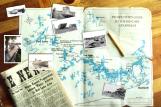1
After the completion of the Northwestern Ontario portion of the Canadian Pacific Railway in 1882, explorers traveled to hamlets scattered along the railway. From these areas, they paddled north following the traditional waterways, which were used as trading routes by the Native people. The route from Hudson to Red Lake was known as the Heritage Waterway.3
During the gold rush of 1925, Hudson boomed overnight when it became the gateway to Red Lake. With the closest railway stop, everything came in by train – people, dogs, mining equipment, explosives, food, alcohol, and even airplanes. Depending on the season, freight was then forwarded by bush plane, tractor train, or scow to Red Lake and beyond.5
Halfway between Hudson and Red Lake, at the Northwest end of Lac Seul, was Gold Pines. Here the travelers could replenish their supplies, play a little poker, and enjoy live entertainment at one of the hotels.From Gold Pines the route followed the English and Chukuni River systems up to Red Lake. It took five to six days to complete the trip.
7
The Heritage Waterway was in operation for 22 years, closing in 1948 when Highway 105 was completed. Until then, travel into the Red Lake area was pretty limited. The only people in this area were here to work. Tourists were non-existent.That all changed once Highway 105 was built, linking Red Lake to the Trans-Canada Highway. Penetrating virgin country, the road unveiled Canada's newest frontier for tourists from around the world; a pristine wilderness, proud First Nations culture, gold rush romance and ethnic diversity.
8
For the first 15 years, the road was so rough that it took over seven hours to get from Red Lake to Vermillion Bay - a scenic drive that now only takes two hours. Motorists often had to get out of their cars to move boulders out of the way, or to push each other’s cars out of the snow drifts.But all minor obstacles aside, this new roadway meant that Red Lake no longer needed to rely strictly on the gold mines to support the economy.
Tourist camps sprung up all over the north along the Waterway to feed the insatiable appetite for big fish. Sport fishing has grown into a significant summertime industry. There are more than 50 tourist camps in operation along the waterway. Places like Gold Pines, Snake Falls and Snowshoe Portage are now operational as tourist camps and attract visitors from around the world. You can still find relics of the gold rush era in these areas.


